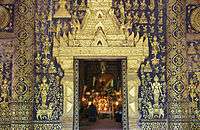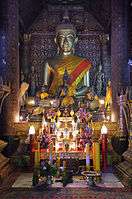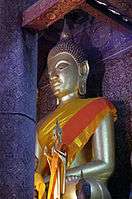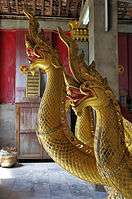Wat Xieng Thong
| Wat Xieng Thong | |
|---|---|
| Xieng Thong Ratsavoravihanh, or Volavihan, the "Golden City or Golden Tree Monastery" | |
 Wat Xieng Thong Sim | |
| General information | |
| Architectural style | Lane Xang Arts style |
| Location | Luang Phrabang, Laos |
| Construction started | 1559 |
| Completed | 1560 |
Wat Xieng Thong (Lao: ວັດຊຽງທອງ; "Temple of the Golden City") is a Buddhist temple (wat), located on the northern tip of the peninsula of Luang Phrabang, Laos. Wat Xieng Thong is one of the most important of Lao monasteries and remains a significant monument to the spirit of religion, royalty and traditional art. There are over twenty structures on the grounds including a sim, shrines, pavilions and residences, in addition to its gardens of various flowers, ornamental shrubs and trees.
History
Wat Xieng Thong was built 1559-1560 by the Lao King Setthathirath near where the Mekong and Nam Khan rivers join. Until 1975 the wat was a royal temple under the patronage of the royal family and the Lao kings were crowned in the wat. The wat is considered as representing typical Laos art and craft. The building of the wat have carved gilded wooden doors depicting scenes from Buddha's life. In the sim the ceiling displays Dharmachakras - dharma wheels symbolising Buddhist law and the circle of reincarnation. The outer walls of the sim depict Lao legends and the rear gable is decorated with a glass mosaic depicting the tree of life. The outer walls of the Sanctuary of the Reclining Buddha, also known as Red Chapel, are decorated with mosaics.[1]
In 1880, the Tripitaka library was added and then the drum tower in 1961. This temple, along with Wat Suwannaphumaham, was spared by any damage during the sacking of the city in 1887. This was because the Black Flag Haw leader, Đèo Văn Trị, had studied here as a monk in his early life, and used it as his headquarters during the sacking of Luang Phrabang. On one side of the sim, there are several small halls and stupas that contain Buddha images of the period. There is a reclining Buddha sanctuary, which contains an especially rare reclining Buddha that dates from the construction of the temple. In 1931, the image was taken to Paris and displayed at the Paris Exhibition and was kept in Vientiane until 1964, where it returned to Luang Phrabang. In the near compound's eastern gate stands the royal funerary carriage house, where it houses the funeral carriage, which stands 12 metres high and there are various urns for the members of the royal family.
A number of restorations have taken place in the twentieth century, included a notable one in which the French participated. In 1928, when the French Governor General visited Luang Prabang, the King Sisavangvong successfully demanded that the French share in the cost of restoration. Major projects took place in the 1950s and 1960s, when the funerary carriage house was built, and especially in more recent times to repair the damage brought by years of neglect because of wars and neglect.
Gallery
 Funeral chapel
Funeral chapel Golden outer wall of Wat Xieng Thong
Golden outer wall of Wat Xieng Thong The inside of Wat Xieng Thong
The inside of Wat Xieng Thong Buddha statue inside of Wat Xieng Thong
Buddha statue inside of Wat Xieng Thong The naga on the ceremonial barge
The naga on the ceremonial barge
See also
References
- ↑ World and its Peoples: Eastern and Southeastern Asia – Cambodia, Laos and Vietnam: Volume 6. Marshall Cavendish. 2007. pp. 798–799. ISBN 978-0-7614-7639-9.
| Wikimedia Commons has media related to Wat Xieng Thong. |
Coordinates: 19°53′51″N 102°8′35″E / 19.89750°N 102.14306°E